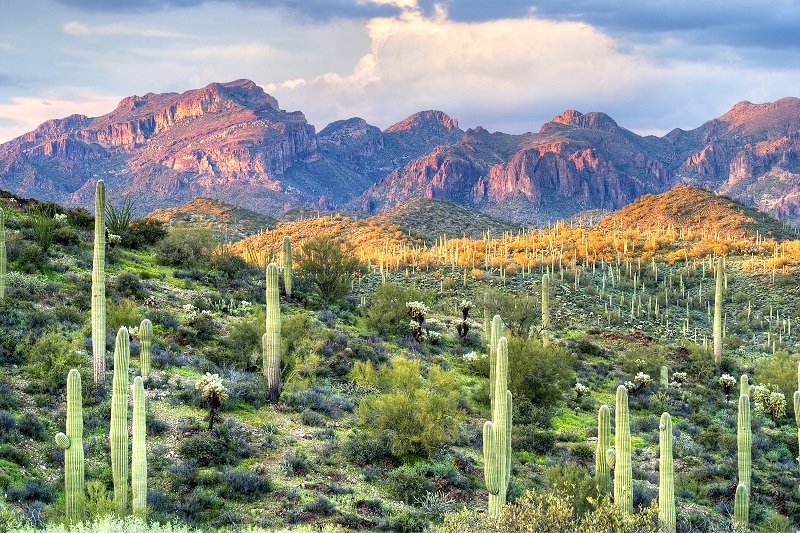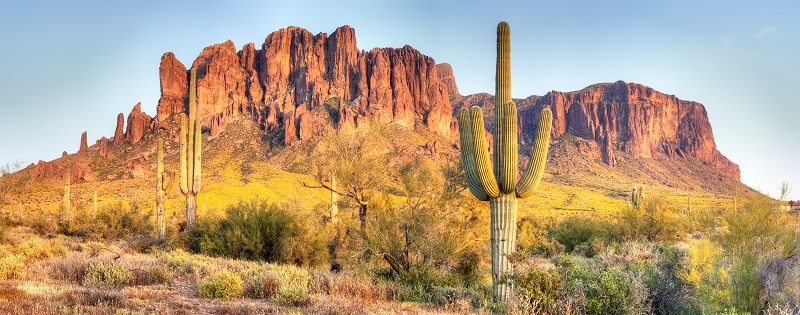
The Sonoran Desert is one of the most captivating places in the world. The desert is stretched across different southwestern parts of the United States and northwestern parts of Mexico.
Sonoran Desert offers a striking mix of mountains and valleys where lives reside against all the odds. Tourists often find themselves amazed by the beautiful sunsets and the incredible variety of wildlife that call this place as their home.
Even if you look at it for once, you will be able to understand that there are various Sonoran desert facts that are hidden from the rest of the world. It has rare Sonoran desert animals and unique Sonoran desert plants that are not seen anywhere else.
This blog will cover everything related to this special place and help you with the list of things that you can experience only here.
The Sonoran Desert covers roughly 100,000 square miles, making it one of the largest and most biologically rich deserts in the world. It spans southern Arizona, southeastern California, and large portions of the Mexican states of Sonora and Baja California. In the United States, much of its land lies within Sonoran desert Arizona, a region known for its picturesque saguaro-filled landscapes and striking mountain backdrops.
Geographically, the Sonoran Desert is bordered by the Mojave Desert to the northwest and the Chihuahuan Desert to the east. What makes it truly unique is the way its topography changes — from broad plains to rocky foothills and deep washes. These variations in elevation and terrain contribute to the extraordinary biodiversity seen here.
One of the most defining features of the Sonoran Desert is its unusual weather. Unlike many deserts that have a single rainy season, this desert experiences two — one in winter and another during the summer monsoon. These seasonal rains nourish the soil, allowing plants and wildlife to thrive in ways that surprise first-time visitors.
This dual-rainfall pattern supports a greater variety of plants and animals compared to other desert ecosystems. The result is a landscape that feels alive and ever-changing, even in its harshest months.
Fascinating Sonoran Desert Facts
The Sonoran Desert’s story is woven from countless remarkable details. Here are a few that capture its essence:
These facts hint at the incredible adaptability of the desert’s life forms. They also highlight the importance of conserving such a rare and rich environment.
Living in the Sonoran Desert is about surviving its temperature extremes and scarcity of water. However, even in this cruel ecosystem there are creatures that reside here that are not found anywhere in the world.
The desert is home to the bobcat, coyote, and javelina. These animals are skilled at finding food and water in the driest months.
The Gila woodpecker and cactus wren nest inside saguaro cacti, taking advantage of the natural protection.
Species like the Gila monster and desert tortoise embody the slow, deliberate pace of desert survival.
Pollinators such as native bees play a critical role in maintaining plant life.
Each species has a story of endurance. The coyote’s opportunistic diet, the tortoise’s ability to store water, and the owl’s silent flight are all results of centuries of adaptation to this landscape.

Perhaps no living symbol represents the Sonoran Desert more than the towering saguaro cactus. But this is just the beginning of the desert’s botanical diversity.
These can live up to 200 years and grow over 40 feet tall in size.
It produces vivid red flowers after rainfall that attracts hummingbirds.
These trees are known for their green bark that helps them in the process of photosynthesis.
It releases a special scent during the rainfall which is referred as the fragrance of this desert.
It offers edible pads and fruit that is vital for both humans and wildlife.
Must Read: Savor the Best Sonoran Food in Phoenix at These Local Gems
These plants do not just survive in these extreme conditions, but they are thriving and building the backbone of an ecosystem that supports countless species. Many are used by local wildlife for shelter and food, while others have long been a part of indigenous diets and medicine.
The Sonoran Desert that is located in the Arizona area is a symbol of history and geological wonders that remains unmatched because of its biodiversity. The large stretches of land are filled with cacti forests, mountains, and hidden canyons. Tourists say that the wildflowers feel like a blanket on the ground during spring.
People often remark on the huge contrast between day and night in the Sonoran Dessert. During daytime, the heat and light seem to push everything into stillness. Whereas at night, the air cools and the desert hums with life.
Top Pick: Wander Phoenix’s Scenic Trails and Embrace the Desert Spirit
When you hear about deserts, you think of its harsh weather and lifeless expanses. However, when it comes to the Sonoran Desert, things look a bit different. This is because the plants and animals here are not just surviving, they are flourishing because of their strong but complex network of adaptations. The region’s weather, its dual rainy seasons, and its varied terrain make it unlike any other desert on the planet.
For those who venture into its expanse, the Sonoran Desert offers more than views as it offers perspective. Here, resilience is not just a trait; it is a way of life. Every cactus spine, every animal track, and every shift in the wind tells part of a larger story — one that has been unfolding for millennia and will continue long after the footprints fade.
This content was created by AI